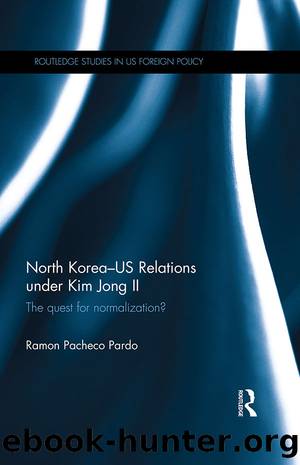North Korea - Us Relations Under Kim Jong II: The Quest for Normalization? by Ramon Pacheco Pardo

Author:Ramon Pacheco Pardo [Pardo, Ramon Pacheco]
Language: eng
Format: epub
Tags: Political Science, General
ISBN: 9781317669524
Google: txOLAwAAQBAJ
Goodreads: 22214488
Publisher: Routledge
Published: 2014-05-09T00:00:00+00:00
5 Nuclear North Korea and the Obama administration
1. The early Obama administration and the second nuclear test, JanuaryâMay 2009
The Obama administration was inaugurated in January 2009. The new administration inherited a country mired in the worst financial crisis since the Great Depression. Hence, the domestic economy became the top priority for the Obama administration during early 2009 (Henry 2009). However, the greater emphasis on domestic affairs did not detract from the administrationâs interest in formulating a coherent foreign policy. The administration had inherited an unstable Greater Middle East, with two ongoing wars in Afghanistan and Iraq, an Iranian nuclear programme, and no solution to the Israeli-Palestinian conflict in sight. Having lived in Indonesia â which has the worldâs largest Muslim population â for four years as a child, Obama had first-hand experience of a predominantly Muslim country. This raised hopes that Obamaâs election to the presidency would improve US relations with the Muslim world (Kull 2011: 3).
Hence, the first months in office of the Obama administration were marked by a shift in US policy towards the Middle East. Obama (2009g) announced that troops would be pulled out more rapidly from Iraq, and newly appointed Secretary of State Hillary Clinton (2009f) called for a negotiated settlement to the Israeli-Palestinian conflict. This suggested a greater role of diplomacy compared to US policy during the early years of the Bush administration. Nonetheless, at the same time the Obama administration showed that it was prepared to pursue more forceful policies in other areas. Vice President Joe Biden (2009) made it clear that even though the new administration was willing to engage Iran, it would put pressure on Tehran if it did not change its stance with regard to its nuclear programme. In the case of Afghanistan, Obama (2009a) announced a troop surge, and pointed to links between instability in that country and the situation in Pakistan. The implicit message was that Washington would not terminate the war in Afghanistan any time soon.
Compared to the situation in the Greater Middle East, on which the Obama administration concentrated its early foreign policy efforts, the outlook was more stable elsewhere. In the case of North-East Asia, with the exception of North Korea, regional relations were improving. In April 2009 Hu and Obama announced the establishment of a bilateral Strategic and Economic Dialogue (Obama 2009c). This was an upgraded version of the two dialogues initiated during the Bush administration, with the Chinese State Councillor and the US Secretary of State joining the Chinese Vice Premier and the US Secretary of the Treasury. Two months earlier Clinton (2009b) had emphasized that Washington and Beijing could work together to each otherâs mutual benefit. The upgraded mechanism and Clintonâs rhetoric indicated that SinoâUS relations would continue to improve. In addition, Clinton (ibid.) reassured Japan and South Korea that the Obama administration would not overlook them.
Furthermore, relations between China, Japan and South Korea were also improving. The three countries held a trilateral Head of Governments summit to discuss security and economic issues in December 2008, marking the first meeting to be held outside of other multilateral frameworks.
Download
This site does not store any files on its server. We only index and link to content provided by other sites. Please contact the content providers to delete copyright contents if any and email us, we'll remove relevant links or contents immediately.
What's Done in Darkness by Kayla Perrin(25490)
Shot Through the Heart: DI Grace Fisher 2 by Isabelle Grey(18208)
Shot Through the Heart by Mercy Celeste(18151)
The Fifty Shades Trilogy & Grey by E L James(17766)
The 3rd Cycle of the Betrayed Series Collection: Extremely Controversial Historical Thrillers (Betrayed Series Boxed set) by McCray Carolyn(13178)
The Subtle Art of Not Giving a F*ck by Mark Manson(12895)
Scorched Earth by Nick Kyme(11821)
Stepbrother Stories 2 - 21 Taboo Story Collection (Brother Sister Stepbrother Stepsister Taboo Pseudo Incest Family Virgin Creampie Pregnant Forced Pregnancy Breeding) by Roxi Harding(11007)
Drei Generationen auf dem Jakobsweg by Stein Pia(10207)
Suna by Ziefle Pia(10176)
Scythe by Neal Shusterman(9249)
International Relations from the Global South; Worlds of Difference; First Edition by Arlene B. Tickner & Karen Smith(8599)
Successful Proposal Strategies for Small Businesses: Using Knowledge Management ot Win Govenment, Private Sector, and International Contracts 3rd Edition by Robert Frey(8404)
This is Going to Hurt by Adam Kay(7679)
Dirty Filthy Fix: A Fixed Trilogy Novella by Laurelin Paige(6444)
He Loves Me...KNOT by RC Boldt(5794)
How to Make Love to a Negro Without Getting Tired by Dany LaFerrière(5366)
Interdimensional Brothel by F4U(5298)
Thankful For Her by Alexa Riley(5148)
